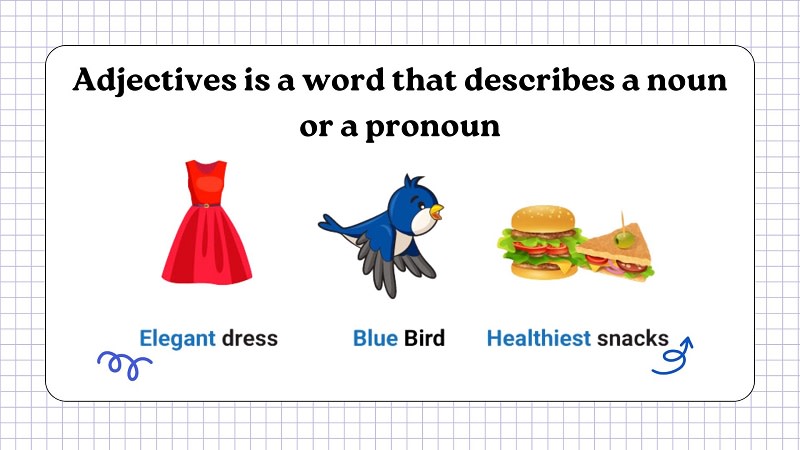Adjectives play an essential role in English by helping readers and listeners visualize and understand the qualities, features, or characteristics of people and things mentioned in a sentence. In this guide, IDP will help you understand what adjectives are, how to use them properly, and how they function in grammar.
1. What Is an Adjective in English?
An adjective, often abbreviated as "adj," is a word used to describe the characteristics or qualities of a person, object, or phenomenon. Adjectives modify nouns, pronouns, or linking verbs.
Examples:
The book is interesting.
He has a big house.
She had excellent credentials for the job.

2. Position of Adjectives in English
Before Nouns
The most common placement of adjectives is directly before the noun they modify.
Note: Some adjectives cannot be placed before nouns, such as: alone, alike, awake, alive, ashamed, alight, fine, ill, glad, poorly, aware, unwell, etc.
Examples:
They have beautiful flower beds in their garden.
He was reading an interesting story.
After Indefinite Pronouns
Adjectives appear after pronouns like something, nothing, anything, someone, anyone, etc.
Example:
There is nothing funny about her story.
After Measurement Phrases Example:
The road is 120 kilometers long.
After Linking Verbs
Adjectives follow linking verbs like be, seem, appear, feel, taste, look, sound, smell.
Example:
I smell burning. What are you cooking?
After Adverbs
Use adjectives after adverbs to emphasize the quality or condition.
Examples:
The food is extremely delicious.
She is incredibly talented.
Adverbs such as very, extremely, incredibly, quite, fairly, rather, somewhat, partly, nearly, almost are commonly used.
Word Order: adverb + adjective + noun.
3. Functions of Adjectives
Descriptive Adjectives
They describe characteristics or qualities.
Colors: green, black, pink
Shapes: round, square
Sizes: large, tiny
Materials: wooden, plastic
Personality traits: kind, selfish
Position: high, near, inside
Proper Adjectives
Derived from proper nouns, always capitalized.
Examples: Vietnamese, Asian, Pacific
Quantitative Adjectives
Show quantity or count.
Examples: one apple, two students, three cars
Demonstrative Adjectives
Indicate specific things or proximity.
Examples: this book, that car, these pens, those chairs
Possessive Adjectives
Indicate ownership.
Examples: my book, her dress, our team
Comparative and Superlative Adjectives
Form | Structure | Example |
Positive | S + V + as + adj + as + N | My house is as big as yours. |
Comparative | S + V + adj-er / more + adj + than + N | She is more intelligent than her brother. |
Superlative | S + V + the + adj-est / most + adj + N | This is the most beautiful beach in Vietnam. |
Adjectives as Nouns
Used with "the" to refer to groups or abstract concepts. Verb remains singular. Examples:
The unemployed need support.
The poor face many challenges.
4. Types of Adjectives Based on Formation
Simple Adjectives Basic adjectives not formed from other words.
Examples: good, strong, beautiful, slow
Compound Adjectives Formed by joining two or more words, usually with hyphens.
Examples: high-quality, well-known, part-time
Adjectives with Prefixes Prefixes alter the root word's meaning.
Examples:
unhappy (un + happy)
dishonest (dis + honest)
impossible (im + possible)
Adjectives with Suffixes Suffixes create new adjectives from root words.
Examples:
beautiful (beauty + -ful)
careless (care + -less)
famous (fame + -ous)
5. Order of Adjectives (OSASCOMP Rule)
When multiple adjectives modify a noun, use the following order: Opinion > Size > Age > Shape > Color > Origin > Material > Purpose
Example:
A beautiful small old round red Italian wooden cooking table
6. Forming Adjectives in English
With Prefixes Common prefixes include: un-, dis-, in-, im-, il-, ir-, non-, over-, under-, pre-, post-, anti-
Examples: unfair, irresponsible, nonviolent, postwar
With Suffixes Common suffixes include: -ful, -less, -ous, -able, -ive, -y, -like, -ish
Examples: powerful, homeless, delicious, portable, attractive
7. Participles Used as Adjectives
Present Participles (V-ing): Describe active qualities.
Examples:
The singing bird
The sleeping baby
Past Participles (V-ed/V3): Describe passive or completed states.
Examples:
The broken window
The stolen car
8. Practice Exercises with Adjectives
Exercise 1: Error Correction
since
The rich
opened
enough potassium
have become
made it possible
to
factors
geographical
friendly
Exercise 2: Complete the Adjectives
beautiful
sleeveless
homeless
handsome
disgusting
exciting
lofty
humorous
boring
dangerous
Exercise 3: Categorize the Adjectives
Opinion: interesting, sensitive
Size: thin, long, thick, short
Age: new, old, young
Shape: oval, round, square, triangle
Color: red, grey, white
Origin: English, Chinese
Material: wooden, woolen
Purpose: walking, racing
Master Adjectives in English with IDP
Adjectives are essential for describing nouns and pronouns clearly and effectively. Mastering adjective usage helps improve both spoken and written English. With regular practice and understanding of categories, structures, and formation, you will confidently use adjectives in any context.
IDP offers high-quality IELTS prep materials, including practice exercises and mock tests. You can also choose computer-delivered IELTS for faster results. Select your preferred test date and register for IELTS with IDP today.
